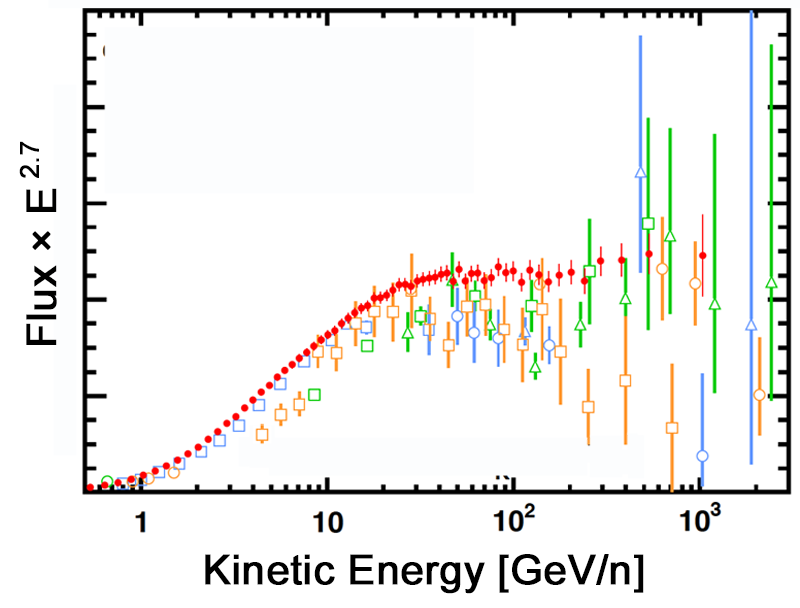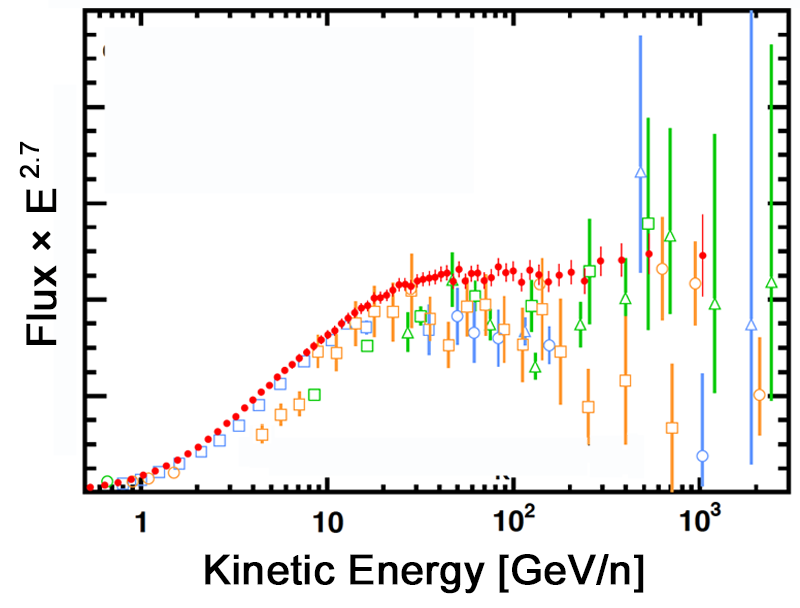New Data Reveal the Heavy Side of Cosmic Rays
An instrument onboard the International Space Station has measured heavy cosmic rays with unprecedented precision. The Alpha Magnetic Spectrometer (AMS) previously revolutionized the study of lighter-element cosmic rays and now provides equally clean spectra for neon, magnesium, and silicon. These spectra reveal features not predicted by existing cosmic-ray models. Improving these models should lead to a better understanding of the supernovae that produce and accelerate cosmic rays and of the interstellar medium, through which they travel.
Most cosmic rays with energies above 1 GeV come from outside of the solar system. These charged particles are 99% protons and helium ions but also include heavier elements. The ions—nuclei stripped of their electrons—are thought to be synthesized mainly in stars and then released and accelerated in supernovae. As the ions travel to Earth, they may be deflected by streams of particles and by magnetic fields, or they can fragment into lighter, “secondary” nuclei when colliding with other particles. As a result, individual cosmic rays usually can’t be traced to their sources. Instead, astronomers observe them coming from all directions, with contributions from many supernovae occurring over millions of years.
Cosmic rays thus carry information on supernovae, on the processes that forged the elements, and on the structure of our Galaxy and of the interstellar medium—information that researchers hope to extract by analyzing spectra for each cosmic-ray element. All known chemical elements are present in cosmic rays, but their prevalence generally decreases with increasing atomic number, reflecting the scarcity of heavier elements in the cosmos. So far, precise spectra have been obtained for the elements from hydrogen to oxygen; measurements of heavier-element spectra have error bars as large as 20%. With such poor data to work with, researchers haven’t previously learned much from these elements’ spectra.
In 2017, the AMS Collaboration reported high-precision spectra of helium, carbon, and oxygen at GeV-to-TeV energies [1]. Now, after collecting data on millions of neon, magnesium, and silicon ions, the team reports similarly precise spectra (error bars smaller than a few percent) for these heavier and scarcer species. AMS determines the species, mass, charge, and energy of each particle by observing how its speed and trajectory are affected by a strong magnetic field in the detector.
For all three elements, the spectrum (the number of detections plotted versus the energy) has a characteristic shape, roughly decreasing with the 3rd power of energy, with some important undulations superimposed. The spectra have undulations similar to those seen in 2017 for helium, carbon, and oxygen. However, the precision of the measurements reveals subtle differences between the spectra of the light and heavy ions. Since “no model can reproduce these spectra,” it’s now up to theorists to make sense of them, says Samuel Ting of the Massachusetts Institute of Technology, who leads the AMS Collaboration.
One of those theorists is Igor Moskalenko of Stanford University, who calls the measurements “spectacular.” He says a full interpretation will require more analysis, but he finds the similarities among all of the spectra to be remarkable because they hint at properties of the interstellar medium. At these energies, the motion of cosmic rays through the interstellar medium can be modeled as the diffusion of charged particles in a turbulent, magnetized medium. Previous data show that silicon has a higher probability of fragmentation than any of the other species. So silicon ions that arrive intact must have come from sources that are closer to us on average than those responsible for the other five elements, says Moskalenko. The similarity between the silicon spectrum and those of the other five elements suggests that the average turbulence of the interstellar medium doesn’t change much over a wide range of spatial scales, he says.
As for the slight differences between heavier and lighter ions, Moskalenko says that they will need to be confirmed by measurements of still heavier cosmic-ray ions, all the way up to iron. But if these differences persist, “they may dramatically alter our understanding of how cosmic rays are produced,” he says. For example, the heavier cosmic rays might be produced by different classes of supernovae than those producing lighter ions.
The results now give theorists a lot of work to do, and they are “opening an entirely new window” on precision cosmic-ray spectroscopy, says Peter Biermann of the Max Planck Institute for Radio Astronomy, Germany. “We can now turn stars into high-energy labs, which the Universe is running for us,” he says.
This research is published in Physical Review Letters.
–Matteo Rini
Matteo Rini is the Editor of Physics Magazine.
References
- M. Aguilar et al., “Observation of the identical rigidity dependence of He, C, and O cosmic rays at high rigidities by the alpha magnetic spectrometer on the international space station,” Phys. Rev. Lett. 119, 251101 (2017).
More Information
First AMS result: Positrons Galore
How cosmic rays propagate: More Hints of Exotic Cosmic-Ray Origin







